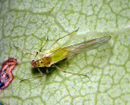Ecological Entomology (2014) 39, 566-577
From Pestinfo-Wiki
 | Selected publication you are invited to contribute to the discussion section (above tab) |
Differing contributions of density dependence and climate to the population dynamics of three eruptive herbivores
Ecological Entomology 39 (5), 566-577
Abstract: 1. Although both endogenous and exogenous processes regulate populations, the current understanding of the contributions from density dependence and climate to the population dynamics of eruptive herbivores remains limited.
2. Using a 17-year time series of three cereal aphid species [Rhopalosiphum padi L., Metopolophium dirhodum (Walker), and Diuraphis noxia (Kurdumov)] compiled from a trapping network spanning the northwestern U.S.A., temporal and spatial patterns associated with population fluctuations, and modelled density dependence in aphid abundances were tested. These models were used to analyse correlations between climate and aphid abundances in the presence and absence of residual variance as a result of density-dependent effects.
3. The temporal dynamics of aphid population fluctuations indicated periodicity, with no clear evidence for a spatial pattern underlying population fluctuations.
4. Aphid abundances oscillated in a manner consistent with delayed density dependence for all three aphid species, although the strength of these feedbacks differed among species.
5. Diuraphis noxia abundances were negatively correlated with increasing temperatures in the absence of density-dependent effects, whereas M. dirhodum abundances were positively correlated with increasing cumulative precipitation in the presence of density-dependent effects; yet, R. padi abundances were unrelated to climate variables irrespective of population feedbacks.
6. Our analysis suggests that endogenous feedbacks differentially regulate aphid populations in the northwestern U.S.A., and these feedbacks may operate at an expansive spatial scale. It is concluded that the contributions of density dependence and climate to aphid population dynamics are species-specific in spite of similar ecological niches, with implications for assessing species responses to climate variability.
(The abstract is excluded from the Creative Commons licence and has been copied with permission by the publisher.)
Link to article at publishers website
Database assignments for author(s): Sanford D. Eigenbrode, Susan E. Halbert, Nilsa A. Bosque-Pérez
Research topic(s) for pests/diseases/weeds:
population dynamics/ epidemiology
environment - cropping system/rotation
Pest and/or beneficial records:
| Beneficial | Pest/Disease/Weed | Crop/Product | Country | Quarant. |
|---|---|---|---|---|
| Diuraphis noxia | U.S.A. (NW) | |||
| Rhopalosiphum padi | U.S.A. (NW) | |||
| Metopolophium dirhodum | U.S.A. (NW) |